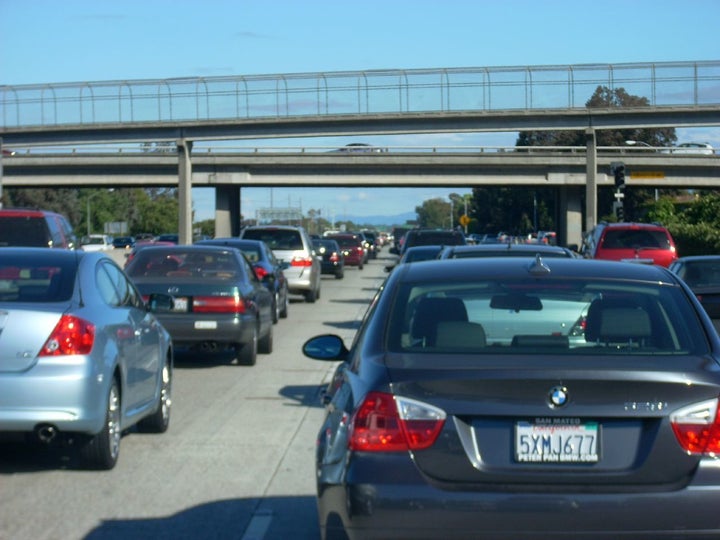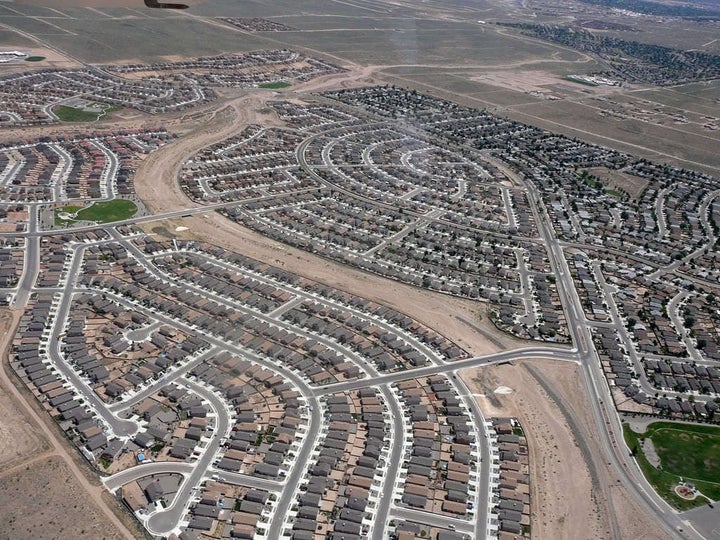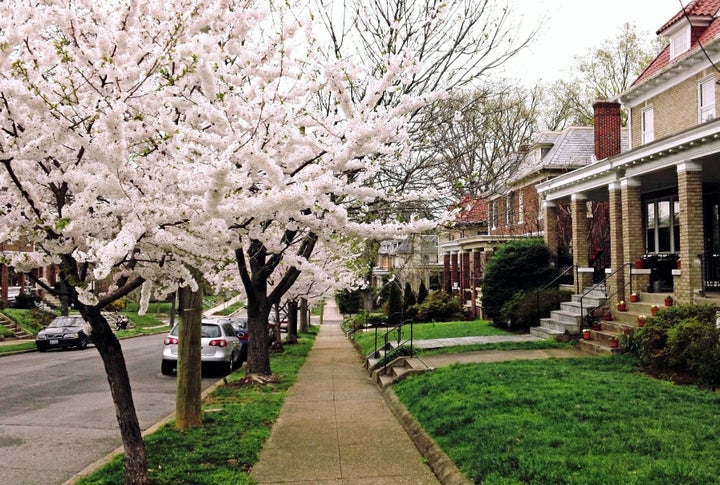
Traffic in Silicon Valley
A large body of city planning research published over the last two or so decades has demonstrated consistently that close-in real estate development produces less driving than does outlying development far from city and regional centers. This makes intuitive sense, of course: spread-out development on or beyond the fringe of metro areas places travel distances relatively farther apart, while more centrally located, relatively denser development tends to place them closer together, shortening driving distances. (More centrally located, relatively denser development can also increase the feasibility and attractiveness of alternatives to driving such as public transit, walking, and bicycling.)
Put another way, if as a city planner or elected official one of your objectives is to slow or reverse the growth of traffic and its associated environmental and economic costs, encouraging development close to the regional center is a useful policy tool to have in your collection of options.
Development location and rates of driving
All this has been confirmed by a thorough, meticulous new “meta-regression analysis” of empirical data from some 37 academic studies on aspects of this and related issues. The quantitative “study of studies” was performed by associate professor Mark Stevens of the University of British Columbia and published in the winter 2017 issue of the Journal of the American Planning Association (JAPA). The most dramatic finding in Stevens’s analysis is that a halving of the distance between a particular development and downtown is likely to reduce per capita driving associated with that development by as much as 32 percent.
To illustrate, let’s compare two different development sites in a hypothetical medium-sized metro area. Let’s place development A, consisting of 75 single-family homes and 10,000 square feet of neighborhood-serving retail, on an inner suburban site that used to be a large parking lot for a now-closed shopping mall, 10 miles from the regional downtown. And let’s place development B, identical to A in all respects but location, on former farmland 20 miles from downtown. Under the statistical relationships calculated by Stevens and reported in his article, residents of development A might reasonably be expected to drive about 32 percent fewer miles, on average, than residents of development B. To turn it around, residents of development B – the more outer location on farmland – might reasonably be expected to drive about 48 percent more miles than residents of development A, the inner suburban site.
That’s a big deal if you care about rates of driving and associated carbon pollution and other tailpipe emissions. As Stevens observes in discussing his research on development location, “this finding highlights the potential value of providing housing in or close to downtown areas.” Indeed, it also highlights the potential of avoiding development in outlying areas, though Stevens does not say so explicitly.
Stevens also studied the effect of additional “compact development” practices – including increasing development density, street connectivity, land use mix, and transit availability – most of which he found to significantly reduce driving. But where it gets interesting is that Stevens doesn’t seem impressed with his own findings, except perhaps to belittle them. His conclusion, rather, is that “compact development features do not appear to have much influence on driving.” Further, he speculates that, because the costs of these practices are likely to be high relative to the small benefits, it may not be worth it to adopt policies promoting such outcomes. I respectfully beg to differ on both counts and will tell you why after some important background on the research linking travel behavior to built-environment characteristics.
Previous research
Stevens’s finding that closer-in development tends to reduce driving is consistent with my much more informal comparison of five new urbanist development locations in various regions and at various distances from their respective downtowns, published in 2015. That finding is also consistent with a description of a purportedly green development I included in my most recent book: in that case, I found that residents of a new subdivision located some 40 miles from downtown Chicago, and literally across the road from a cornfield, were likely to generate four times the carbon emissions from transportation as residents of downtown Chicago and almost twice the per capita emissions generated by residents of the Chicago metro region as a whole.

Outlying development in Rio Rancho, New Mexico
More important, Stevens’s finding with respect to development location is consistent with what has been the gold standard of academic research in this field since 2010, Professors Reid Ewing and Robert Cervero’s “Travel and the Built Environment: A Meta-Analysis,” also published in the Journal of the American Planning Association. When Ewing and Cervero’s work came out, I called it “the definitive study of how land use affects travel behavior.” (Ewing is Department Chair and Professor of City and Metropolitan Planning at the University of Utah; Cervero is Friesen Chair of Urban Studies and Director of the University of California Transportation Center.)
Using a methodology very similar to that employed by Stevens – but basing it on the smaller sample of empirical studies available to them at the time – Ewing and Cervero concluded not only that closer-in development locations reduced driving compared to outer locations but also that reduced rates of driving were associated (albeit to a lesser extent) with greater street connectivity, increased mix of land uses, closer transit availability, and increased residential density.
Ewing and Cervero emphasized that the effect on driving of a central location was much greater than that of the other factors, such that “almost any development in a central location is likely to generate less automobile travel than the best-designed, compact, mixed-use development in a remote location.” They also noted, however, that the combined effect of several built-environment variables on travel could be “quite large.” These conclusions were consistent with those contained in an earlier, extensive but less quantitatively sophisticated synthesis of literature on the subject published by Ewing and Cervero in 2001.
In their 2010 meta-analysis, Ewing and Cervero also calculated the effects of those same built-environment variables on walking and transit use. They concluded that all five had statistically significant impacts on the two modes, with street network connectivity having the most significant influence on walking – residents are likely to walk more if streets are well connected – and, as might be expected, nearby transit presence having the most significant impact on transit use.
How the new research relates to the previous work
Back to the 2017 study, Stevens did not examine walking and transit use. But, with regard to the impacts of development characteristics on driving, he clearly based much of his work on Ewing and Cervero’s model, referring to their earlier work often in his article. He examined the same variables and went through much of the same methodology. And he reached similar results, by and large, except if anything he found most of the land use factors to be somewhat more significant in influencing driving than did Ewing and Cervero.
Stevens also considers his work to add important methodological sophistication to Ewing and Cervero’s work, controlling for the potentially confounding factors of self-selection of research subjects and bias among editors in the publication of research. (This is pretty esoteric stuff; but, basically, statistical analysts who fret over self-selection are concerned that, for example, residents of a neighborhood with low rates of driving might be driving less not because the neighborhood causes them to do so but because they prefer to drive less and the neighborhood merely enables them to.)

A close-in DC neighborhood with low driving rates
Let’s look at some of the other land use factors (besides proximity to downtown) found by Stevens to be influential in affecting driving behavior. They basically are the same ones cited by Ewing and Cervero. Translating Stevens’s statistical elasticities into more accessible English, one can conclude from the analysis that, for every doubling of local density, we should expect a 22 percent drop in vehicle miles traveled per capita. For every doubling of street connectivity (as measured by, say, intersections per square mile), we should expect a 14 percent decrease in driving. For every halving of the distance to the nearest transit stop, we should expect a decrease in driving of about 2.5 percent. Conversely, for every change of these variables in the opposite direction, we should expect driving to increase proportionately.
(With respect to land use mix, Stevens’s results are a bit murky. If one doubles the measurable land use mix – by, for instance, doubling the number of shops, amenities and/or jobs reachable within walking distance of residences – the base elasticity reported by Stevens finds that driving per capita should decline by about three percent. That’s intuitive, if not a very large change. But Stevens asserts that, after controlling for self-selection bias, we really should expect driving to increase by eleven percent. I can’t help but suspect that some undiscovered factor may be distorting that result.)
Why these findings matter despite the author’s skepticism
As noted, Stevens believes that changes in development characteristics such as location, density, street connectivity, transit access and land use mix “do not appear to have much influence on driving.” But that’s just not the case.
Using Stevens’s own numbers, we have already seen from our hypothetical comparison of outlying development on farmland to redevelopment of an inner suburban parking lot that the differences in driving rates between the two can be quite significant. To extend the comparison, if the closer-in redevelopment were placed in a setting that included not only single-family homes but also some townhomes and/or apartments – and we added comparable density to the new development – driving might be reduced even further. If we built the new development on a street grid with more connectivity than that afforded by the outlying project, we might reduce it further still. Heck, if we chose to build on a former industrial site only three miles from downtown rather than on the inner suburban parking lot, the differences when compared to the greenfield site could become quite dramatic indeed.
Stevens further suggests that a cost-benefit analysis of promoting compact development would probably reveal that the costs are too high to justify the benefits. But I believe the opposite is true: it is spread-out development that costs too much to be fiscally sustainable, because it requires more infrastructure per unit of development than do inner, more compactly designed neighborhoods. The costs are compounded because the infrastructure must be maintained over time. Service costs (such as those associated with postal and parcel delivery) are also higher on a per-unit basis because of increased transportation costs. And household transportation costs can be higher in spread-out development, too, as thoroughly documented in the Center for Neighborhood Technology’s impressive Housing and Transportation Affordability Index.

Compact development provides a great walking environment in Sanford, Florida
Moreover, the benefits associated with compact development practices are not limited to reducing driving rates. In an excellent commentary on Stevens’s article, Ewing and Cervero cite dozens of academic studies documenting additional benefits of compact development, including but not limited to increased walking and transit use, reduced residential energy consumption, increased physical activity and reduced obesity, and increased social interaction and neighborliness. (Ewing and Cervero’s commentary, along with several others, was published concurrently with the Stevens article in the same JAPA issue.) Compact development also reduces fragmentation and consumption of the landscape and its ecological resources (including, for example, watersheds and wildlife habitat) and scenic beauty.
Finally, I believe both Stevens and Ewing and Cervero may considerably underestimate the potential effect of public transit in producing lower rates of per-capita driving. This is because the measure of transit presence used in both sets of research – the distance from a household to the nearest transit stop – is too simplistic: distance to the nearest stop may tell us that there is some nearby transit (or not), but it does not tell us anything about the amount and quality of available transit, which matter greatly. Consider, for example, a single bus stop, located a quarter-mile from a home, on a bus line that provides hourly service to downtown. Now compare that to a busier bus stop in the same location providing access to multiple bus lines with service every ten minutes along different routes, plus a light rail station a third of a mile away providing express service downtown, again every ten minutes. Both cases would score exactly the same in the researchers’ analyses; but the latter is far more likely to reduce driving than the former.
The bottom line
I have long been convinced that the benefits to reducing driving of changes in local development density, street connectivity and land use mix are limited if not accompanied by a favorable location within the region. This isn’t news. But the advantages of close-in development locations – and the disadvantages of outlying ones – are immense, and they should not be minimized.
In particular, planners and elected officials are facing choices about where to encourage new development in their regions and where to discourage it. Stevens’s findings – like those of Ewing and Cervero before him – provide important new support for the proposition that, if a goal is to slow or reverse the growth of regional traffic, one would be foolish to encourage, say, outer development on farmland and discourage it on closer-in redevelopment and infill sites. Rather, one should do just the opposite.
And we shouldn’t stop there. In part to reduce driving further and in part to encourage walking, we should also prioritize locations with good transit service and street connectivity, and with walkable access to shops and amenities. If these things don’t already exist, we should encourage developers to provide them. Density, for its part, should be tailored to the circumstances; personally, I believe we can achieve a lot with moderate urban density that retains a human scale. We should employ these strategies while bearing in mind Ewing and Cervero’s reminder that, even if the effect of any one particular factor on driving is relatively small, the combined effect of several could be quite large.
All of these features won’t be optimized in all neighborhoods or new developments, and that’s fine. Sometimes compromises will be made, and that’s fine, too. In the real world, there are competing goals and things are messier than in academic research or online articles. But let’s keep at it. I believe these development characteristics are important to creating great cities filled with great neighborhoods that people love, and Stevens’s data – if not his conclusions – are helpful to the cause.
Kaid Benfield writes about community, development, and the environment on Huffington Post and in other national media. Kaid’s latest book is People Habitat: 25 Ways to Think About Greener, Healthier Cities.
